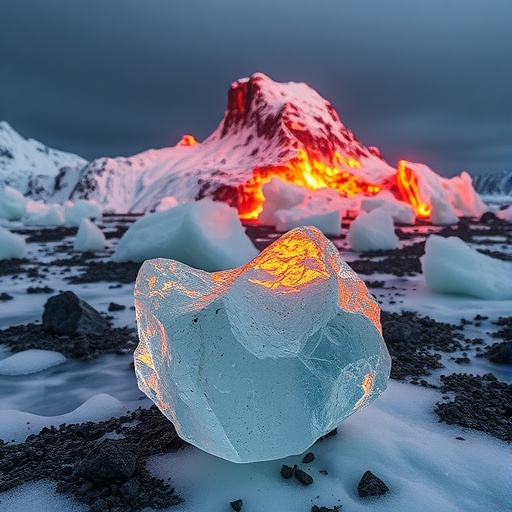In a groundbreaking study that combines cutting-edge technology with the insights of geohistory, researchers have set their sights on the enigmatic volcanic eruption that transpired in 1458/59 CE. The research team, led by renowned scientists from diverse fields, analyzed glass shards extracted from the firn core located in the frigid expanse of Antarctica’s Vostok Station. This analysis not only sheds light on the eruption itself but also provides critical data about global climatic variations during that era.
The significance of studying volcanic eruptions cannot be overstated, especially as they possess the potential to disrupt climate patterns and influence human history. The 1458/59 CE eruption, whose origins were previously shrouded in mystery, has finally been scrutinized through innovative methodologies that measure the isotopic and chemical composition of volcanic glass. With the convergence of environmental science and advanced analytical techniques, the researchers have unwrapped the secrets hidden within these ancient glass shards, yielding insights that apply to both past and future volcanic activities.
Powerful eruptions are known to release sulfur dioxide into the atmosphere, resulting in the formation of sulfate aerosols. This phenomenon can lead to a significant reduction in global temperatures, often dubbed as “volcanic winters.” The implications of such climatic disruptions on agriculture and human health are profound, thus highlighting the importance of understanding historical eruptions like the one in 1458/59 CE. By unraveling the source of this eruption, present-day scientists can also gauge its potential similarities to modern volcanic activities, offering essential knowledge for climate prediction and disaster preparedness.
The firn core from Vostok Station serves as a crucial archive of Earth’s climatic history. Layers of snowfall accumulate and compact over millennia, eventually transforming into ice. Within these layers, the trapped air bubbles encapsulate not only atmospheric gases but also particulates like volcanic ash and glass shards. The research team’s choice of firn core was deliberate, as its preservation of volcanic materials enables a robust analysis of the eruption’s characteristics and its broader environmental impact.
Through meticulous analysis, the researchers were able to determine that the volcanic shards were chemically similar to those originating from a particular volcanic structure in the Southern Hemisphere. This finding is pivotal, as it not only links the eruption to a geographic source but also enhances our understanding of the global volcanic systems operating during the mid-15th century. The data suggest that this eruption could be part of a pattern of increased volcanic activity that characterized the period, known as the Little Ice Age, which saw a number of significant volcanic events.
As the researchers delved deeper into the isotopic ratios of the glass shards, they uncovered marked differences that revealed insights into the magma’s composition and the tectonic processes at play. Using high-precision techniques for elemental analysis, they could discern the evolution of the magma leading up to the eruption event. One of the findings indicated a higher volatile content in the magma, which signifies that such eruptions can be abrupt and more explosive. This understanding of the magma’s behavioral characteristics proves critical for predicting future eruptions and assessing their risks.
The timeline of the eruption is also a subject of interest to researchers. Synchronization of historical records with geological data is a complex task. However, the linkage established between ice core samples and documented climate anomalies around the time of the eruption helps to contextualize its global impact. This integration of historical and geological data reveals that following the eruption, there were observable disturbances in climate patterns, characterized by subsequent colder years.
Furthermore, the aftermath of the 1458/59 CE eruption has implications for future volcanic studies. As global climate change continues to alter weather patterns and potentially amplify the effects of volcanic eruptions, comprehensive studies like this one establish a baseline that scientists can use for future predictions. It emphasizes that understanding historical volcanic events is not merely an academic exercise, but a necessity for improving societal resilience against natural disasters.
In conclusion, the comprehensive analysis of the glass shards from the firn core at Vostok Station has unearthed invaluable insights into the volcanic eruption of 1458/59 CE. By employing advanced methodologies and drawing from interdisciplinary knowledge, this research highlights the intimate connection between volcanic activity and climate, a relationship that is more pressing than ever in the context of global change. This study serves not only as a testament to past events but also as a vital resource in preparing for future geological phenomena.
In the grand scheme of Earth’s climatic narrative, each eruption contributes a stanza to the tale, a reminder of nature’s power and unpredictability. As we delve into the quakes of the past, we pave a road of knowledge that will guide us through the uncertainties of the future. Researchers are now better equipped to understand the processes that shape our planet, ensuring that we remain vigilant and informed stewards of our environment.
This pioneering work illustrates the importance of using advanced analytical techniques to study past events that shape our present world. Truly, the integration of history, science, and technology has commenced a new era of understanding regarding volcanic eruptions and their profound impact on Earth’s climatic conditions.
Subject of Research: Volcanic eruptions and their climatic impact, specifically the eruption of 1458/59 CE.
Article Title: Origin of the 1458/59 CE volcanic eruption revealed through analysis of glass shards in the firn core from Antarctic Vostok station.
Article References:
Ro, S., Hur, S.D., Ekaykin, A. et al. Origin of the 1458/59 CE volcanic eruption revealed through analysis of glass shards in the firn core from Antarctic Vostok station.
Commun Earth Environ 6, 828 (2025). https://doi.org/10.1038/s43247-025-02797-x
Image Credits: AI Generated
DOI: 10.1038/s43247-025-02797-x
Keywords: Volcanic eruption, 1458/59 CE, Vostok Station, glass shards, firn core, climate impact, geological analysis.




